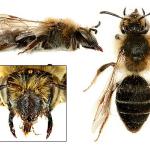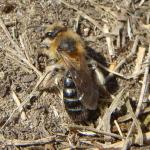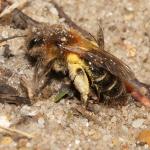This medium-sized, spring-flying Andrena is strongly associated with loose, dry sandy soils. The females are quite colourful when fresh, but soon become dowdy. The males, which race over the surface of loose sand in the sun, wear out even more quickly and a bright silver-grey insect rapidly becomes a dull browny-black with few obvious hairs. It is closely related to the similar, but smaller and summer-flying, Andrena argentata Smith.
It is found throughout the British Isles, although scarcer towards the north, also recorded from the Channel Islands and scattered localities in Ireland.
It is widely distributed in northern and central Europe.
This species is not regarded as scarce or threatened.
Strongly associated with light, sandy soils, but widespread on these.
March to June.
Nests in the ground, forming small aggregations; usually in patches of loose sand although they also nest between the paving stones in my sandy garden. The females allow the burrow to collapse behind them as they enter and leave, possibly hiding the entrance. The actual nest is made in the firmer sand underneath, so excessive soil disturbance is damaging to the nests.
There are flower-visiting records for a wide range of spring-flowering shrubs as well as herbaceous species such as dandelion.
Unusually for an Andrena, its special cleptoparasitic bee is a Sphecodes – pellucidus Smith. One is often alerted to its probable presence by the Sphecodes flying over loose sand and digging into it as it searches for nest burrows of the Andrena.
2016




